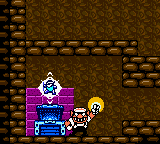Wario Land 3 follows its predecessor's puzzle-platforming formula with two key changes: Wario slowly acquires his abilities (a la Metroid), and instead of 50 levels there are just 25–but each holds four different chests to unlock for a total of 100 goals.
Just as in II, Wario is immortal, but enemies cause him to transform in ways that appear painful but are actually helpful. For example, being flattened by a Thwomp-like enemy puts Wario into a cartoony feather-like state: now he can float into small gaps. One transformation from the previous game, where he became tiny, has been removed. In its place, bats make him a vampire that can turn into a bat! Most transformations last a few seconds, but the vampire remains until he touches water. The vast majority of the game's puzzles are solved by using the appropriate transformation. They aren't overly difficult. Since Wario can't be hurt or killed, the game can only punish you by making you try a segment again. I confess that a few times I used the Switch's rewind feature to avoid the ten seconds or so it would take to get Wario back to where I messed something up.
 |
| Vampiric Wario |
In his normal form, Wario can destroy enemies with his characteristic shoulder slam (press B). Jumping on them only stuns them, which also lets him pick up and throw them (once he has re-obtained this ability). He can eventually power-throw enemies (hold B, then release).
Having to acquire Wario's abilities allows the designers to gatekeep treasures. For example, without the high jump (hold ↑) Wario can't reach some platforms; without the ground pound (push ↓) he can't break blocks beneath him. I enjoyed this change–I'm a huge Metroid fan after all–and it makes the game easier for newcomers. Whenever he gets a new ability, an animation shows you exactly how to use it.
The idea of four locked chests with corresponding keys (gray, red, green, and blue, in that order) is compelling. I've been trying to find all 100 treasures and, I'll admit, am getting a bit tired of some stages. Revisiting a stage for the fourth time, even with access to a new area, can become repetitive. Getting a treasure often causes something to happen on the world map (divided into N, E, S, and W regions) or in certain stages. For example, a pump causes underwater platforms to rise. Thus progress is dependent upon getting certain treasures. Watch what happens on the map to see where to go, or return to the starting temple and hold ↑: the game tells which stage to play next.
The game uses a day-and-night system; after each stage it changes. This effects some of the stages, but for the vast majority I didn't notice anything. Differences were subtle or non-existent.
A small change from II that I dislike is that Wario no longer drops coins when hit by an enemy. That little extra penalty made enemies more meaninful to me. In this game, coins are virtually meaningless because I almost always had the maximum 999. There is no longer a coin-tracker on the main menu showing how many you've found across all playing.
Coins' sole use is to play the golfing mini-game in some levels. The game is basic: you don't aim, as the course is linear. You swing using the standard, relex-based meter seen in all NES golf games. If you get the ball into the hole within par, you win. You have to watch out for bunkers, rough, and water. It shows you where the ball will land if hit at maximum strength, so you can use that to gauge. I didn't much enjoy it. Finishing a hole removes a barrier in that stage (labeled "Mini game"), behind which one of the chests will be found.
Every stage also holds eight big coins. You don't have to find them all at once. I have yet to collect all eight in any stage, let alone the entire game (and I doubt I will). Apparently if you do, a new stage of the mini-game becomes available, so that is a treat for completionists.
 |
| I was not surprised when the mysterious head betrayed Wario. |
The game has quite a few interesting boss fights, each unique. The end-boss is a bit underwhelming, in my opinion. Weirdly, if you lose to him, you get a Game Over message, otherwise impossible in a game with an immortal protagonist!
Each of the 25 stages has its own theme, like town, volcano, river, jungle, or pit. The volume and variety of the game is its biggest asset. There are many hours of fun to be had in this 8-bit cartridge.
It's amazing to think Nintendo developed 8-bit games for nearly 20 years. The progression from Donkey Kong in 1982 to Wario Land 3 in 2000 is remarkable. Wario Land 3 was the last Game Boy Color game made by Nintendo R&D 1, who began with Mario Bros. and Baseball on the Famicom/NES! R&D2 made Kirby Tilt 'n' Tumble, which released a few months later. They began with the Donkey Kong games for the Famicom/NES. What an era!
Wario Land 3 is a great sequel to a great game. Graphically and musically, it's very similar to II (still not a fan of the weird music). I highly recommend the game for Game Boy fans, although I probably slightly prefer the previous one because it has 50 levels, and for the coin tracker!
 |
| Grade: A |
Linked Review
"If you enjoyed the previous adventure then this generously expanded outing is likely to please you even more."
— Marcel van Duyn, Nintendo Life, 9/10




Comments
Post a Comment